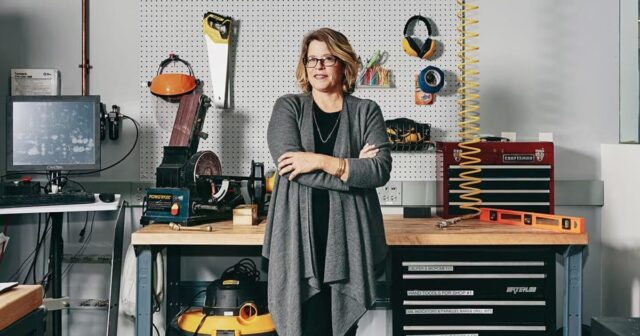“From the start, The Engine Ventures has recognized the importance of decarbonizing steelmaking and has been instrumental in helping us grow and scale our technology,” said Tadeu Carneiro, CEO of Boston Metal. He added, “Anyone who knows climatetech knows that Katie Rae is a real changemaker.”
Sublime Systems, a leading cement decarbonization startup, also credits the MIT-built enterprise with supporting its spinout from the lab. Sublime makes low-carbon cement by electrically charging a bath of chemicals and calcium silicate rocks — without using fossil fuels. The startup’s cofounders, Leah Ellis and Yet-Ming Chiang, developed the process while at MIT and now operate a pilot plant in Somerville, Massachusetts.
The Engine Ventures has invested $11 million in Sublime, or nearly a fifth of the startup’s total current investment, and Rae also serves on the board. In March, the company was selected for an $87 million DOE investment to build its first commercial-scale plant in Holyoke, Massachusetts. Sublime also recently celebrated a milestone when its product was poured for the first time at a commercial office park project in Boston.
“Tough-tech companies are working to radically change the world for the better — but they require patient capital to scale out of the lab and into commercial relevance,” said Ellis, who is also Sublime’s CEO. “The Engine has played a pivotal role in building this needed capital base and ecosystem that supports companies like Sublime as we work towards swift and massive impact.”

Nearly eight years in, the VC fund has had one exit to date: artificial intelligence startup Zapata AI, which went public in March via a special-purpose acquisition company. But The Engine Ventures isn’t sweating the numbers just yet. Rae said that the firm’s investors include endowments, foundations, family offices, and pension funds, all of which are taking “a slightly longer-term view” when it comes to earning financial returns.
“We’re going after markets that take a longer time [to develop], but you have a bigger market; that’s the trade-off that you’re making,” she said. “We’re shooting to have $50 to $100 billion exits here,” a level few public or privately held firms have achieved. “These will be very large companies.”
Industrial decarb needs much more money — and policy
Dramatically boosting venture capital funding is only one step that has to happen before Rae’s vision can become a reality — at least when it comes to reshaping heavy industries.
In the first quarter of 2024, the low-carbon industry sector raised $302 million in venture capital and private equity (VC/PE) investment worldwide, plus another $45 million in public financing. That amounts to 3 percent of the $11.3 billion in total climatetech funding for the period, according to a BNEF report shared with Canary Media.
The numbers show that industrial decarbonization “is severely underfunded as a sector,” BNEF’s Curry said. A separate BNEF analysis found that VC/PE funding for low-carbon industries would have to double in order to match the sector’s contributions to global emissions.
Low-carbon transport, meanwhile, is consistently overfunded relative to its emissions impact. That’s largely because there are clear consumer market signals for cleaner vehicles, as well as increasingly stringent federal and state rules for curbing tailpipe emissions, all of which make vehicle and battery startups a more obvious play for investors. Customer demand for cleaner — and likely more expensive — building materials and chemicals is far less certain.
Curry said that while federal incentives and industrial funding programs created by the Biden administration will help, without a mandate or a price on CO2 emissions, most green materials aren’t likely to become cost-competitive. And manufacturers and construction firms are unlikely to change their operations or place big orders for novel, carbon-free products on their own. In the European Union, the cap-and-trade system is the main driver of industrial decarbonization.
Without a robust buyer’s market and a clear business model, investors may not have the confidence to invest at the level needed to scale up these cutting-edge technologies.
Several high-profile initiatives are striving to jump-start the global market for greener building materials by pooling demand from giant corporations, some of which say they’re willing to pay an initial premium. In the United States, the federal government and California have adopted “buy clean” programs designed to leverage the vast purchasing power of public agencies to drive demand for low-carbon products.
Curry said that many industrial startups struggle to make the shift from VC funding to growth equity — meaning bigger checks from private equity investors to build demonstration projects. She noted that Boston Metal has successfully navigated that transition, mainly because it’s producing extremely valuable metals in addition to steel, a low-margin commodity.
For Rae, the latest fund raised for The Engine Ventures represents “an affirmation of the work that we’ve done.”
The $398 million infusion announced this month will drive “a kind of doubling down on our strategy, on the companies we invest in, and the kinds of founders we invest in,” she said.




